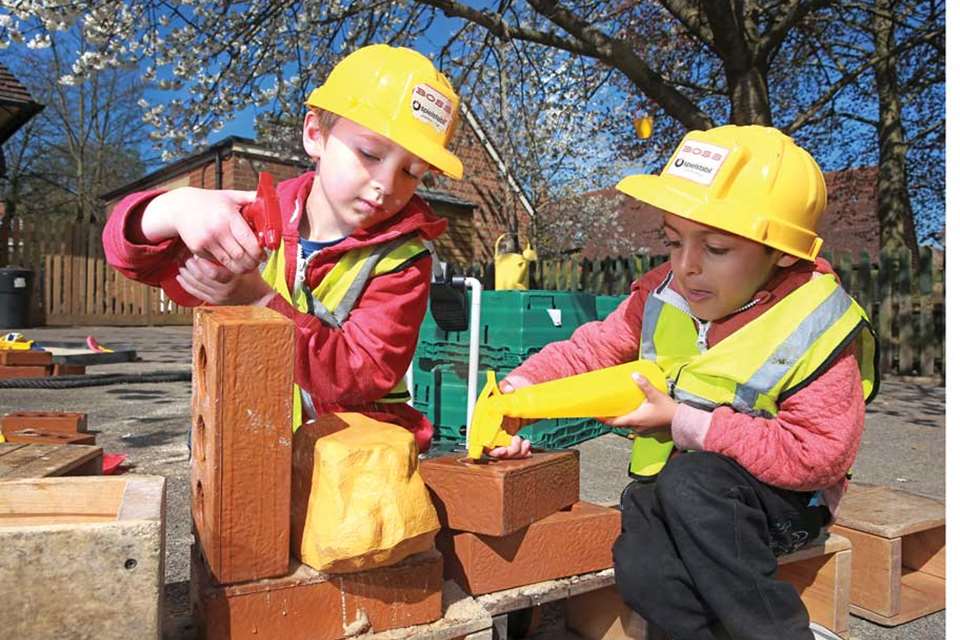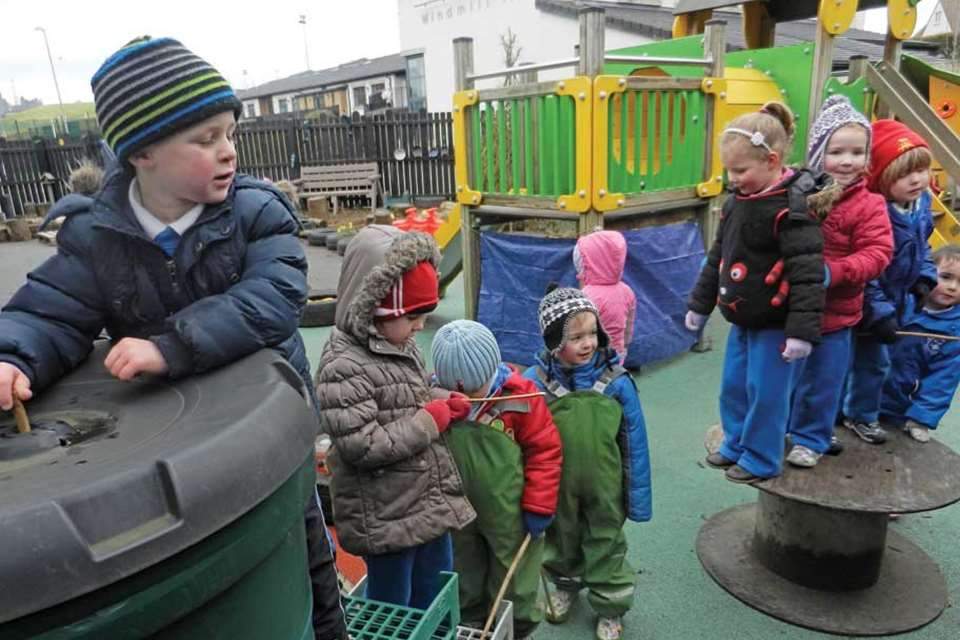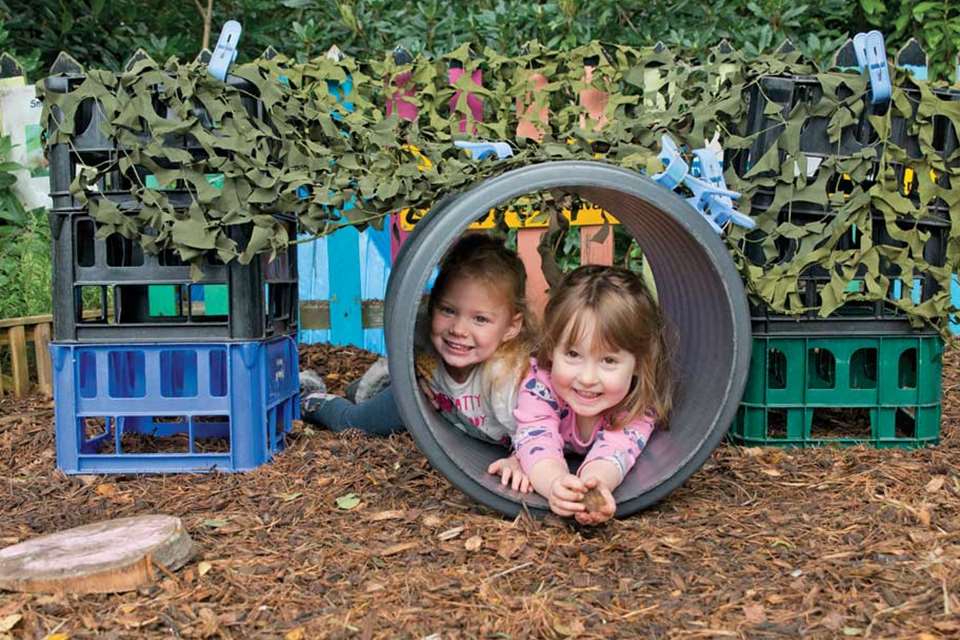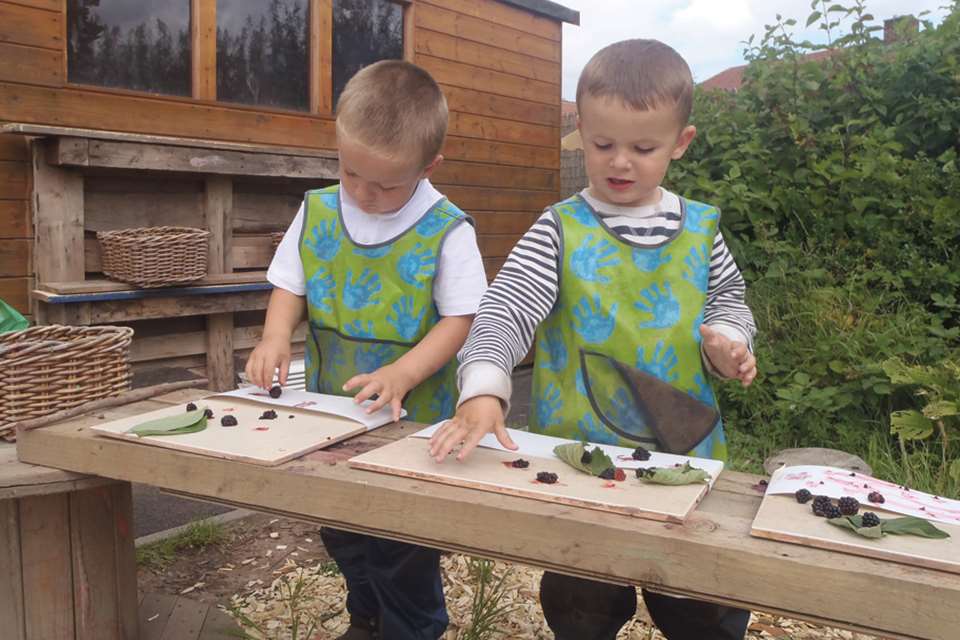Enabling Environments: Outdoors - In full swing
Sue Duglan
Monday, October 19, 2015
Action research has helped to develop a nursery garden to better provide open-ended opportunities for learning, as well improving practice. Teacher Sue Duglan breaks down the transformation.

The garden at Ludwick Nursery School, in Welwyn Garden City, is a large space shared by children in both the nursery school and Squirrels Day Nursery. It needed attention to make it a more stimulating resource, promoting rich open-ended learning opportunities, while practitioners needed to become confident in providing challenging physical play experiences. Part of that transformation was made possible through an action research project (see also box).
Physical Development (PD) became a prime curriculum area in the revised Statutory Framework for the Early Years Foundation Stage (2012), reinforcing its crucial importance in early development and the need for children to have a diet of movement-rich experiences, which underpin all learning.
The starting point of my research was examining the variety of open-ended PD experiences on offer within our garden. The Physical Development Masters module at the Centre for Research in Early Childhood (CREC) in Birmingham provided the framework for this research.

THE PROCESS OF ACTION RESEARCH
Audit
Designed by outdoor play consultant Jan White, the audit aimed to find out what was available across the garden to promote movement and communication and to develop ideas for physical play at home with families (White, 2015).
Practitioners felt there were extensive physical play opportunities available. However, the frequency of some experiences was limited, due to constraints such as time, organisation of resources, weat- her and supporting challenge and risk.
Children's voices
The information about the children's preferences revealed that they were interested in:
- movement and speed - for example, running or riding bikes
- climbing - on the grassy banks, trees or steps
- prospect - being up high with a view was a dominant feature
- spinning and turning - by rolling on the grassy areas or using skateboards
- manipulation of body in space - for example, using their arm and body strength to hang or pull carts.
Practitioners' views
I designed a questionnaire to support the introduction of wider experiential provision. The results suggested that:
- staff needed more time, or to use time more efficiently, to organise resources
- practitioners wanted to have a greater voice about what was happening in the garden
- the theme of ownership correlated closely with individual staff interests and comfort levels
- providing open-ended experiences in response to children's interests had a positive effect on quality, with children showing more sustained involvement and adult interactions with children becoming more personalised
- practitioners shared a similar belief about the availability of resources daily and time allocated to child-initiated learning.
A series of meetings, some led by Jan White, provided an opportunity for all stakeholders to commit to making the garden stimulating and open-ended. It was divided into areas, with 'ownership' split among staff groups, making it smarter and easier to set up and clear up resources.
Finding a focus
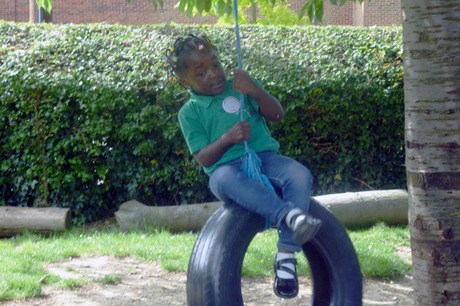 I decided to focus on a garden swing, as it provided scope for children to practise a range of movements - and experience different sensations - in response to changing stimuli.
I decided to focus on a garden swing, as it provided scope for children to practise a range of movements - and experience different sensations - in response to changing stimuli.
While undertaking this research, I was able to observe how practitioners at St Thomas Children's Centre, in Birmingham, had hung ropes and bread crates from a suspended ladder to make swings and attached stretchy fabric to create gentle rockers.
It was interesting to see recycled materials providing stimulating and complex movement opportunities. As well as promoting physical and social development, the swing challenged children's thinking and prompted adventurous physical learning.
The relationship between body and environment can potentially promote self-expression, allowing children to become confident and capable learners. However, Moss (2012) suggests there is often a deficit between the time children require for developing physical and spiritual well-being and the time actually at their disposal to spend outside in space and nature.
I was inspired to explore this idea further as it connected directly to my observations of how children's interests evolve, as well as their natural drive for movement.
Developing practitioners' skills and practice
To create the swing we hung a rope over a tree branch and used a tyre for the seat. It soon became clear that I needed to address how to bring all practitioners on board with the project. Initially, many adults had concerns that the swing would hit another child. I could see this reflec- ted in their language, with comments such as, 'Careful, you might hit' or 'I'll hold this rope so you don't fall.'
However, it was important to promote a culture of self-selected challenge as there is much research suggesting children are able to assess potential hazards and self-regulate if they are allowed to choose to explore challenge in safe supported play.
REAPING THE BENEFITS
I soon began to observe various benefits of the swing:
1. Flexibility: Its open-ended nature allowed children to access it in different ways. Some naturally had the strength to pull themselves off the ground. As well as the physical benefits this skills brings, it enabled children to explore concepts of force, gravity, distance, speed and cause and effect.
2. Self-challenge: With repeated exposure to the swing, children became more confident and devised more difficult challenges for themselves. I used observations to convince practitioners that the children were fascinated, driven and emotionally connected with the new resource.
3. Perspective: I found a big attraction of the swing for children was the opportunity it provided to view things from a different perspective. For example, in hanging upside down, they experienced gravity as their hair fell away from their head, along with a different sensation in their bodies. The familiar became unfamiliar, providing new thrills and challenges.
4. Social development and communication: Changing perspective and working together to move the tyre provided opportunities for negotiation, while turn-taking and supporting each other occurred naturally and promoted communication skills.
Challenge versus risk
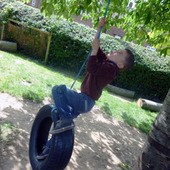 To promote positive adult interactions, I daily modelled opportunities to embrace challenge, and as staff confidence grew more practitioners were prepared to either step back and observe from a distance or engage in supportive dialogue with children as they played on the swing. This encouraged children to take the initiative and develop their own strategies for responsible risk taking.
To promote positive adult interactions, I daily modelled opportunities to embrace challenge, and as staff confidence grew more practitioners were prepared to either step back and observe from a distance or engage in supportive dialogue with children as they played on the swing. This encouraged children to take the initiative and develop their own strategies for responsible risk taking.
Their change of viewpoint enabled practitioners to consider eliminating 'hazards' rather than removing all risks. I noted how dialogue changed, and now there is more debate about the potential of what a child can do.
The parents were very positive about the impact of the swing and they now share with us more of their children's experiences of physical learning at home.
The most significant impact of this study has been the change in attitudes. Now parents value and provide more time for physical activities, while practitioners have confidence to allow children to keep themselves safe as they identify new challenges.
CONCLUSIONS
The whole process of observation, planning and reflection has produced wide-ranging benefits. The main changes have been:
- the supportive peer 'buddying' between nursery and daycare staff has promoted debate to improve practice and learning outcomes
- enhanced communication between practitioners and parents regarding movement experiences
- building on open-ended learning outcomes and seeing how children interact in the garden in a new light
- an open productive discussion forum on challenge for both practitioners and children
- recognition of the value of learning achievements outdoors
- all practitioners have individual responsibilities for maintaining and developing outdoor provision and regularly check its efficacy by using quality provision audits
- practitioners now put more emphasis on the need to ensure inclusive provision and provide for all dispositions for learning, by providing opportunities for curiosity, creativity, motivation, determination and positive and flexible thinking.
OUTDOOR ELEMENTS
Through the Mosaic approach, we observe children's interests and give them a voice to express their views and ideas, so our garden is developing constantly and reflects the following elements:
Physicality and movement These are vital components of child development and play, and the swing led to more opportunities for the children to climb and swing.
Softness Grassy and planted areas, for example, provide places of sanctuary and links to nature and ecology.
Refuge Dens and cosy spaces provide natural seclusion, support the development of awe and wonder and enable children to exercise autonomy by deciding where they want to seek shelter.
Prospect Viewing a landscape from different heights and angles helps children to make sense of their place within an environment.
Affordance Open-ended materials as well as features such as slopes and pathways provide infinite scope for investigation, chance and challenge, alone or with supportive adults.
Pd masters module
- The framework for the research was provided by the MA Education (Early Years) Children's Physical Development (birth-seven) module, tutored by Jan White, CREC, St Thomas Children's Centre, Birmingham. For more information, call 0121 464 0020, email enquiries@crec.co.uk, or see www.crec.co.uk, and https://janwhitenaturalplay.wordpress.com
More information
- 'Natural Childhood' report, S Moss (2012), www.nationaltrust.org.uk/document1355766991839
- Playing and Learning Outdoors: making provision for high quality experiences in the outdoor environment with children 3-7 by J White (2014) (2nd edition), Routledge
- Every Child a Mover: a practical guide to providing young children with the movement experiences they need by J White, (2015), Early Education
- Listening to Children: the Mosaic approach (2nd edition) by Clark, A and Moss, P (2011).
Sue Duglan is a teacher at Ludwick Nursery School, Welwyn Garden City, Hertfordshire


